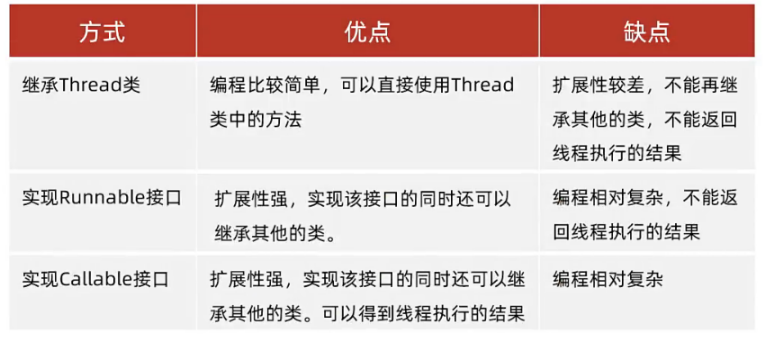线程的三种创建方式

1 // 方式一:继承Thread类 2 public class Thread{ 3 public static void main(String[] args) { 4 Thread t = new MyThread(); 5 t.start(); 6 7 for (int i = 0; i < 5; i++) { 8 System.out.println("主线程:" + i); 9 } 10 } 11 } 12 13 public class MyThread extends Thread { 14 @Override 15 public void run(){ 16 for (int i = 0; i < 5; i++) { 17 System.out.println("子线程:" + i); 18 } 19 } 20 }
1 /* 2 创建线程方式二、实现 Runnable接口 3 */ 4 public class ThreadDemo2 { 5 public static void main(String[] args) { 6 Runnable r = new MyRunnable(); 7 Thread t = new Thread(r); 8 t.start(); 9 for (int i = 0; i < 5; i++) { 10 System.out.println("主线程:" + i); 11 } 12 } 13 } 14 15 public class MyRunnable implements Runnable { 16 @Override 17 public void run() { 18 for (int i = 0; i < 5; i++) { 19 System.out.println("任务线程:" + i); 20 } 21 } 22 }
public class ThreadDemo2_mini { /* 线程创建方式二 、实现Runnable接口(匿名内部类方式) */ public static void main(String[] args) { Runnable r = new Runnable() { @Override public void run() { for (int i = 0; i < 5; i++) { System.out.println("子线程1:" + i); } } }; Thread t = new Thread(r); t.start(); // 同上简化 new Thread(new Runnable() { @Override public void run() { for (int i = 0; i < 5; i++) { System.out.println("子线程2:" + i); } } }).start(); // 同上简化 new Thread(() -> { for (int i = 0; i < 5; i++) { System.out.println("子线程3:" + i); } }).start(); for (int i = 0; i < 5; i++) { System.out.println("主线程:" + i); } } }
/* 方式三:实现Collable接口 */ public class ThreadDemo3 { public static void main(String[] args) { // 创建 Callable 任务对象 // 线程1 Callable<String> call = new MyCallable(50); // 把 Callable 任务对象 交给 FutureTask 对象 // FutureTask 对象作用 1:是 Runnable 的对象 (实现了 Runnable 接口),可以交给 Thread // FutureTask 对象作用 2: 可以在线程执行完毕之后通过调用 get 方法得到线程执行完成的结果 FutureTask<String> task = new FutureTask<>(call); // 交给线程 Thread t = new Thread(task); // 启动线程 t.start(); // 线程 2 Callable<String> call2 = new MyCallable(100); FutureTask<String> task2 = new FutureTask<>(call2); Thread t2 = new Thread(task2); t2.start(); // 获取线程执行完的结果 try { // 如果任务没有执行完毕这里会先等待,等任务执行完之后在提取结果 String s = task.get(); System.out.println("线程1:" + s); } catch (Exception e) { e.printStackTrace(); } try { // 如果任务没有执行完毕这里会先等待,等任务执行完之后在提取结果 String s2 = task2.get(); System.out.println("线程2:" + s2); } catch (Exception e) { e.printStackTrace(); } } } public class MyCallable implements Callable<String> { /* 定义一个任务类、实现 Callable 接口、应申明线程结束后的结果类型 */ private int n; public MyCallable(int n){ this.n = n; } // 重写 call 方法 @Override public String call() throws Exception { int sum = 0; for (int i = 0; i <= n; i++) { sum += i; } return "子线程结果是:" + sum; } }
本文作者:小※兽
本文链接:https://www.cnblogs.com/dsds/p/17995142
版权声明:本作品采用知识共享署名-非商业性使用-禁止演绎 2.5 中国大陆许可协议进行许可。





【推荐】国内首个AI IDE,深度理解中文开发场景,立即下载体验Trae
【推荐】编程新体验,更懂你的AI,立即体验豆包MarsCode编程助手
【推荐】抖音旗下AI助手豆包,你的智能百科全书,全免费不限次数
【推荐】轻量又高性能的 SSH 工具 IShell:AI 加持,快人一步